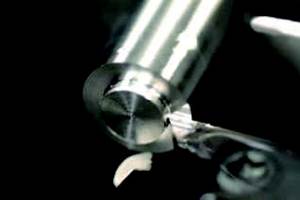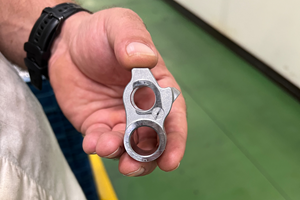A Tool To Help With Jaw Boring
Machining soft jaws remains one of the most tedious and time-consuming tasks for turning centers, so anything you can do to organize and simplify this task will speed up your setups. In order to make the workholding setup when soft jaws must be machined, the setup person must remove the current top tooling from the chuck, find the set of jaws to be used for the new setup, mount the jaws to the chuck, clamp on some form of temporary plug or ring, and machine the jaws.
Share






Machining soft jaws remains one of the most tedious and time-consuming tasks for turning centers, so anything you can do to organize and simplify this task will speed up your setups. In order to make the workholding setup when soft jaws must be machined, the setup person must
- remove the current top tooling from the chuck,
- find the set of jaws to be used for the new setup,
- mount the jaws to the chuck,
- clamp on some form of temporary plug or ring, and
- machine the jaws.
A little organization will go a long way to minimizing the setup time related to getting soft jaws ready to use. Convenient and organized jaw storage, for example, can minimize much of the searching a setup person must do in order to find and store jaws. It should go without saying that setup people must put jaws back where they belong when they're removed from the chuck. As basic as this sounds, I'm always amazed by companies that do little or nothing when it comes to organized jaw storage. I've seen many setup people search the shop (taking a great deal of time) to find a needed set of jaws.
When it comes to mounting jaws, the style of chuck determines what is involved with jaw placement. Some chucks require cumbersome methods. The serrations on the jaws are commonly quite fine, making the jaws difficult to place precisely. A series of rings on the face of the chuck must be used to help with placement. Two cap screws per jaw must be tightened. If a jaw is misplaced, the whole process must be repeated. I've seen novice setup people take thirty minutes just to place a set of three jaws on the chuck.
By comparison, quick jaw-change chucks make jaw placement much easier and faster. The serrations of these jaws are usually coarser, making proper placement considerably easier to judge. A tee-wrench is used to help mount each jaw. In many cases, jaws can be easily placed on the chuck in less than ten seconds per jaw.
Once jaws are mounted, most applications require that they be machined to ensure concentricity with the main spindle. In order to bore jaws to the proper size, the setup person must first clamp the jaws on a temporary plug so that the master jaws are close to about the middle of their stroke. Again, some organization and prior thought can save countless hours of setup time. A great deal of setup time can be wasted while the setup person searches the shop for an appropriately sized chucking plug. Worse, you may have to make one to fit the jaws.
One solution to this problem is to keep a set of chucking plugs close by each turning center. Make them in 1/8-inch diameter increments to ensure that setup people always have an appropriately sized plug at their fingertips.
An attendee from one of my seminars suggested making an adjustable tool from hex stock. Having this tool in two or three sizes will usually handle all the jaws you bore. Notice the hole in the middle of the tool. It's used to line up the center of this plug with a series of concentric circles drawn on a piece of paper. If the circles are clearly marked (in 1/8-inch increments), the setup person can quickly and precisely set the adjustable screws to provide the appropriate chucking diameter.
The actual act of boring the jaws has been the topic of previous CNC Tech Talk columns (September 1991 and July 1996), so only the main points will be repeated here. First, programming the jaw boring process will minimize setup time. A parametric program can even be developed to allow the jaw size to be quickly specified prior to boring. Second, if you do bore jaws manually, be sure you calibrate the position display page to match the tool's position. This will keep setup people from guessing at diameters and depths that are being machined.
Related Content
Shoulder Milling Cuts Racing Part's Cycle Time By Over 50%
Pairing a shoulder mill with a five-axis machine has cut costs and cycle times for one of TTI Machine’s parts, enabling it to support a niche racing community.
Read MoreToolpath Improves Chip Management for Swiss-Type Lathes
This simple change to a Swiss-type turning machine’s toolpath can dramatically improve its ability to manage chips.
Read MoreCustom PCD Tools Extend Shop’s Tool Life Upward of Ten Times
Adopting PCD tooling has extended FT Precision’s tool life from days to months — and the test drill is still going strong.
Read MoreFinding the Right Tools for a Turning Shop
Xcelicut is a startup shop that has grown thanks to the right machines, cutting tools, grants and other resources.
Read MoreRead Next
Last Chance! 2025 Top Shops Benchmarking Survey Still Open Through April 30
Don’t miss out! 91ÊÓƵÍøÕ¾ÎÛ's Top Shops Benchmarking Survey is still open — but not for long. This is your last chance to a receive free, customized benchmarking report that includes actionable feedback across several shopfloor and business metrics.
Read MoreAMRs Are Moving Into Manufacturing: 4 Considerations for Implementation
AMRs can provide a flexible, easy-to-use automation platform so long as manufacturers choose a suitable task and prepare their facilities.
Read MoreMachine Shop MBA
Making Chips and 91ÊÓƵÍøÕ¾ÎÛ are teaming up for a new podcast series called Machine Shop MBA—designed to help manufacturers measure their success against the industry’s best. Through the lens of the Top Shops benchmarking program, the series explores the KPIs that set high-performing shops apart, from machine utilization and first-pass yield to employee engagement and revenue per employee.
Read More.jpg;width=70;height=70;mode=crop)


















